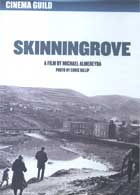
Skinningrove 2013
Distributed by Cinema Guild, 115 West 30th Street, Suite 800, New York, NY 10001; 212-685-6242
Produced by Chris Killip, Michael Almereyda.
Directed by Michael Almereyda
DVD , color and b&w, 15 min.
Sr. High - General Adult
Films, Photography, History
Date Entered: 06/20/2014
Reviewed by Oksana Dykyj, Head, Visual Media Resources, Concordia University, MontrealFilmmaker Michael Almereyda’s Skinningrove, is a fifteen-minute documentary about photographer Chris Killip’s years-long 1980s photographic documentation of the town of Skinningrove, North Yorkshire in England. The format of the documentary is fitting to both men’s pasts: Killip has been teaching at Harvard since 1991 and is a professor of Visual and Environmental Studies there, and Almereyda had attended Harvard in the 1980s as an art student before turning to film. Filmed on March 2, 2012 at the Carpenter Center and set up as a cross between a personal reminiscence and a more formal lecture, Killip projects and comments upon the series of photographs he took of the landscapes and the people of this small insular village. The black and white photographs speak to the far-reaching economic effects of Thatcher’s government on the area and on its inhabitants. This closely-knit community kept to itself but accepted Killip into their fold and his affection for these people is effectively shown in his inclusion of a young man who sports punk attire and in one photograph proudly displays his new LP record of Punk and Disorderly, a punk music compilation from 1982.
At the time of the documentary only four of Killip’s Skinningrove photographs had been published in books. He is clearly moved when he talks about the history of this village and the ties he formed with the people in it over the years he returned to take pictures. His immersion into the culture of the town is poignantly brought out in his selection of photographs of young men he befriended, who eventually died in a fishing accident. Almereyda is able to completely sublimate himself and allow Chris Killip’s words and images speak for themselves in a pared down, minimalist approach which turns out to be the most valuable way of highlighting the photographs and their place in history. For more information on Chris Killip, you can refer to his interview with Michael Almereyda, Aperture Magazine, New York, Fall 2012, Issue 208. http://www.chriskillip.com/interviews.html This documentary is very highly recommended for anyone interested in photography, particularly ethnographic photography, as well as economic history of the U.K.